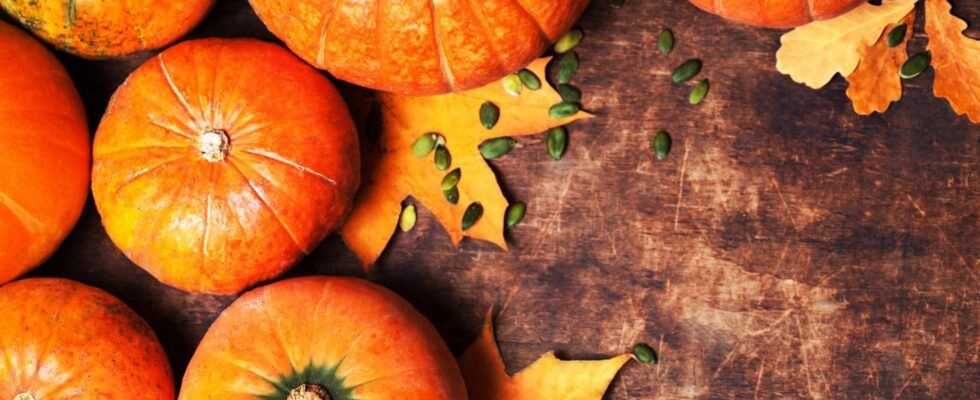When we think of pumpkin, we usually think of the Hokkaido pumpkin – there is no other vegetable that we associate so much with autumn. And although he's still almost a newcomer in this country, we're already hopelessly in love!
The Hokkaido is a pumpkin that originally comes from Japan. The most popular type of pumpkin is "Uchiki kuri", which is now available in almost every supermarket. But it also makes it really easy for us: The Hokkaido pumpkin is incredibly versatile and very easy to prepare. Because of its thin shell, it has to not even be peeled. You can simply cook the shell until soft and then eat it, for example as a pumpkin soup. This also makes it interesting for those amateur cooks who have so far avoided the pumpkin for fear of peeling.
What does Hokkaido actually taste like?
In terms of taste, the Hokkaido pumpkin has a lot to offer: Being mild, nutty aroma offers an excellent basis for pumpkin soups, pumpkin pie and creative dishes from pumpkin risotto and pumpkin jam to pumpkin lasagna. It goes particularly well with ginger and chilli, which is why pumpkin chutney and pumpkin curry with Hokkaido are very popular.
The pulp from Hokkaido remains firm to the bite and stable, and that he hardly any fibers also makes the meal very pleasant. The best recipe ideas with Hokkaidopumpkin We have put together for you from the BRIGITTE test kitchen:
If you want to turn your pumpkin dish into a real eye-catcher, you can hollow out the pumpkin and prepare and fill the pumpkin to your heart's content, for example vegan with an aromatic couscous or with an autumn chilli or ragout. There are (almost) no limits to your imagination.
Cooking with Hokkaido – that's important
You don't have to peel the pumpkin, but it is important, the Hokkaido wash thoroughly. This is best done under running, warm water. Rub it thoroughly all around. This is how you free it from superficial dirt and residues. If you want to be on the safe side, it's best to buy Organic Hokkaido. Then it is guaranteed to be free of harmful substances and chemicals.
You can recognize a fresh pumpkin with the Knock test: Simply tap the bowl with your knuckle. It is optimal if a hollow noise is heard, then the Hokkaido pumpkin has reached the right degree of ripeness. Other important indicators are one plump, flawless skin and an intact stem base.
You should have him at home store in a cool, dry place. Then the Hokkaido lasts for up to two months. The pulp, cut into cubes, is stored in the freezer for several months. Here we explain how you can freeze the pumpkin. This is especially useful if you have a lot of pulp left over from the pumpkin carving. By the way, you don't have to throw away the seeds, we explain how you can roast pumpkin seeds.
This is why the Hokkaido pumpkin is so healthy
In addition to its versatility and its great aroma, the orange-red pumpkin is also great low in calories and fat and rich in vitamins. Just 26 kcal per 100 grams of Hokkaido pumpkin. You can feast more often there.
You can tell that the pumpkin is healthy by the high nutrient density: Compared to other types of pumpkin, it contains less water and a lot Beta carotene. Just 100 grams of pumpkin meat cover the daily requirement of beta-carotene, which our body can convert into vitamin A. This is important for one good eyesight, strong skin and hair.
Then there are the Vitamins B1, B2 and B6, vitamins C and E as well as folic acid, magnesium, iron and phosphorus – and all in just one vegetable! What more do you want?
Growing Hokkaido yourself – is that possible?
As already mentioned, this pumpkin originally comes from Japan. It was bred on the island of Hokkaido, to which it owes its name, from the rice nut squash that the Americans introduced there at the end of the 19th century. It has only been grown in this country for about 20 years.
If you want to grow Hokkaido yourself, you should Sow seeds in May. Ideally, you prefer young plants in the greenhouse in spring and then put the pumpkin plants outdoors in May. The sowing of Hokkaidos is needed a lot of spacebecause they develop long tendrils. Therefore, when growing, make sure you have one between the individual plants Distance of at least 1.50 meters to be observed. They get along particularly well with sunflowers and sweet corn as neighbors, which can also provide some shade.
As soon as the first fruits develop, the pumpkin develops one increased water requirements. Therefore, water the pumpkins very regularly and directly on the ground. If too much water gets on the leaves, there is a risk of powdery mildew. Apart from that, the Hokkaido is not particularly maintenance-intensive. You should just make sure that the plants do not develop too many long shoots. They cost the Uchiki kuri a lot of strength and energy. Cut them back regularly so that the plants are forced to focus on the fruit.
In the fall you should do the Hokkaido Leave outside as long as possibleso that it can gain weight and taste. However, you have to harvest the pumpkins necessarily before the first frost. Then store the Hokkaido pumpkin in a cool (up to 15 degrees) and dry place, preferably in the cellar.
VIDEO: Hokkaido pumpkin cream soup
